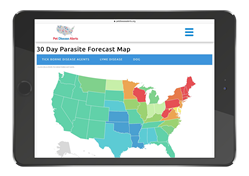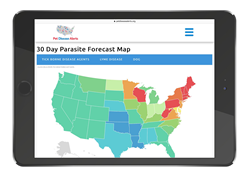
The new 30-Day Pet Parasite Forecast Maps at PetDiseaseAlerts.org are designed to alert pet owners and veterinarians about vector-borne diseases before they occur.
CAPC recommends Michigan pet owners talk to local veterinarians about year-round protection from Lyme and Ehrlichiosis – transmitted by ticks – with annual testing and preventatives.
SALEM, Ore. (PRWEB)
May 04, 2022
The nonprofit Companion Animal Parasite Council (CAPC) — the nation’s leading source on parasitic diseases that threaten the health of pets and people — is forecasting higher-than-normal risk for Lyme disease and Ehrlichiosis in Detroit, Michigan, as well as throughout Wayne, Washtenaw, Macomb, Oakland, and Livingston counties for May 2022.
In its mission to monitor and report emerging threats to companion animals, CAPC developed 30-Day Pet Parasite Forecast Maps to alert pet owners of impending disease outbreaks in their local communities. These monthly forecast maps can be found at PetDiseaseAlerts.org and currently forecast four parasitic diseases (Lyme, Ehrlichiosis, Anaplasmosis and Heartworm) based on analysis of recent disease prevalence trends in every county across the United States.
“Lyme Disease and Ehrlichiosis are serious threats to pets in Michigan that are increasingly vulnerable to these debilitating and potentially fatal illneses,” said Dr. Rick Marrinson, DVM, and CAPC board member. “The new 30-Day Pet Parasite Forecast Maps at PetDiseaseAlerts.org are designed to alert pet owners and veterinarians about vector-borne diseases before they occur.”
Please click here for pre-packaged video news segment for download/use highlighting details outlined below:
-
Lyme disease and Ehrlichiosis Forecast in Michigan – May 2022
Lyme disease and Ehrlichiosis are bacterial illnesses that can be transmitted to humans, dogs and other animals by certain species of ticks. The ticks that carry Lyme and Ehrlichiosis are often found in tall grass, thick brush, marshes and woods. Although found in Michigan year-round, ticks tend to be more active in warm weather, so pets are at greater risk in the spring and summer. Analysis of 30-Day Pet Parasite Forecast Maps for the state of Michigan indicate higher-than-usual activity in Detroit and throughout Wayne County, with nearby counties such as Washtenaw, Macomb, Oakland and Livingston showing infection risk levels that are higher than past years. Overall, the forecast maps indicates the Ixodes tick that transmits Lyme and Ehrlichiosis is moving into Michigan from the northwest with counties in the northwestern part of the state forecasted to be high risk, with the risk moving southward. CAPC expects this trend to continue throughout 2022.
- Why Should Pet Owners Be Concerned?
Lyme disease and Ehrlichiosis are bacterial infections transmitted through the bite of an infected tick and can infect both dogs and their families. These diseases are similar in that many dogs don’t show signs of infection, but those that do exhibit symptoms such as fever, depression, loss of appetite, lethargy, joint pain and stiffness. In some cases, if undetected or untreated, Lyme disease can lead to issues such as kidney failure, heart issues and/or neurological issues. Similarly, dogs infected with Ehrlichiosis can experience eye issues, lameness and/or bleeding issues and anemia. People cannot catch Lyme disease or Ehrlichiosis directly from an infected dog, but the same ticks that bite dogs can also bite humans. This means that if there are infected dogs in an area, there are infected ticks that may transmit disease to humans.
- What Should Pet Owners Do?
As we head into summer and spend more time outdoors with our pets, talk to your local veterinarian about testing for tick-borne diseases and year-round tick-prevention. Pet owners should be diligent about checking for ticks after spending time outdoors. Both Lyme and Ehrlichiosis are treatable with antibiotics if identified early.
It’s difficult to prevent a dog’s exposure to ticks, especially when they are outdoors in areas ticks inhabit. Year-round use of tick preventatives help limit infestations. This will also help prevent pets from bringing ticks into the home, limiting exposure to family members, as these diseases can also affect humans. For dogs in areas with high risk for Lyme disease, pet owners should also talk to their veterinarian about vaccinating against Lyme. Staying aware of the threat level of tick-borne disease in your local community and areas where you travel with your pet is also important.
Pet Disease Alert’s 30-Day Pet Parasite Forecast Maps help pet owners visualize high-risk areas for Lyme and Ehrlichiosis, and also serve as an early-warning system for areas of emerging risk. If dogs test positive in an area for Lyme or Ehrlichiosis, then humans are at increased risk too. The 30-Day Pet Parasite Forecasts are updated monthly so pet owners can see the risks at home and across the country before they occur. CAPC encourages pet owners and veterinarians to consult these maps regularly in order to protect pets and families from parasitic diseases.
Recognized as the global expert in forecasting vector-borne diseases of U.S. companion animals, CAPC indicates that risks have increased nationally due to:
- Increased travel with pets
- Rehoming of pets due to natural disaster and the transportation of rescue pets
- Distribution and prevalence of vector (mosquito and tick) populations
- Shifting wildlife populations, and their incursion into newly developed and reclaimed areas
- Short- and long-term changes in climatic conditions
- Changes in habitat due to natural or human-induced processes
CAPC’s forecasts – supported by ongoing research by parasitologists and statisticians in leading academic institutions across the United States – highlight areas where more should be done to lower the risk of companion animals’ exposure to disease vectors, such as mosquitos and ticks. The foundation of these prevention strategies are recommendations that veterinarians and pet owners test their pets annually for disease and protect them with products that kill or repel mosquitos and ticks, as well as year-round heartworm prevention.
“Because of the zoonotic potential of parasitic diseases – meaning they can be transmitted from animals to humans – we created our 30-Day Pet Parasite Forecasts to alert communities of the risk to people and pets locally,” said Dr. Christopher Carpenter, DVM, and CEO of CAPC. “Over the years, we’ve seen the risk for parasitic diseases increase and expand into areas that have had historically lower prevalence. CAPC’s monthly Pet Parasite Forecasts are critical to alerting pet owners to the risks and reinforcing CAPC’s recommendation that all pets need to be annually tested and protected year-round.”
To view local 30-Day Pet Parasite Forecast Maps, as well as the daily Flea Forecast, visit http://www.petdiseasealerts.org.
How the Forecasts Are Created
The 30-Day CAPC Pet Parasite Forecast Maps are a collaborative effort from parasitologists and statisticians in leading academic institutions across the United States who engage in ongoing research and data interpretation to better understand and monitor vector-borne disease agent transmission and changing life cycles of parasites. The forecasts are based on many factors including temperature, precipitation and population density.
About Pet Disease Alerts
Pet Disease Alerts (http://www.petdiseasealerts.org) is a nonprofit focused on alerting pet owners to the threat of pet diseases in their local areas. Established by the Companion Animal Parasite Council (CAPC) in 2018, Pet Disease Alerts was founded to directly communicate crucial, time-sensitive information about disease threats, encouraging pet owners to be proactive by visiting their veterinarian to get their pets tested and protected.
About the Companion Animal Parasite Council
The Companion Animal Parasite Council (http://www.capcvet.org) is an independent not-for-profit foundation comprised of parasitologists, veterinarians, medical, public health and other professionals that provides information for the optimal control of internal and external parasites that threaten the health of pets and people. Formed in 2002, CAPC works to help veterinary professionals and pet owners develop the best practices in parasite management that protect pets from parasitic infections and reduce the risk of zoonotic parasite transmission.
###
Share article on social media or email:

